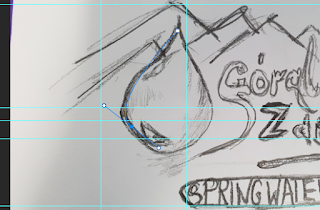Hi!
Today I am going to look at water art and discuss that subject. Water is a lot of contrasting meanings and symbols. Almost a still mirror, a smooth surface and calmness, and at the same time a raging whirlpool, an element that can not be tamed, chaos. Aquatic motifs accompany art for centuries. Sometimes they dominate, embracing entire layers of canvases, and sometimes they hide behind, constituting only a substitute for the landscape.
 |
| https://www.markmitchellpaintings.com/blog/the-depiction-of-water-in-art/ |
Water for the ancients constituted cleanliness, hygiene and the basis of some philosophical trends. The Old Testament, for it, abounds in a sinister and destructive manifestation of this element, including in the motive of the deluge. During the Renaissance people tried to reflect the beauty of nature, and the water usually created an idyllic and calm atmosphere. Romanticism, however, completely contradicted it, destroying the classic concept with bold brushstrokes under which the foamy sea waves swirled. The changes introduced by the Impressionists mainly concerned the rejection of the subject in flavors of showing the moment. They paid attention to m.in. on the weather, time of day and season, so water was an inseparable element of contemporary canvases. The concept of presenting the theme of water has changed over the centuries.
 |
| https://www.markmitchellpaintings.com/blog/the-depiction-of-water-in-art/ |
 |
| http://www.tapeterie.com/birth-of-venus-botticelli.html?___store=en&___from_store=en |
The painting above depicts the mythological theme of the birth of the goddess, which emerges from the sea foam dressed only in long hair buds. The water around the shell is whirling, which is the only disturbance of the gently wavy surface. The impression of peace and idyll dominates, unmoved. The distant horizon gives the impression of an endless pool that almost spills over the left side of the canvas. The flickering of the water was shown by means of fish-shaped pulls. The giving Zefir stimulates only a fragment of the sheet, without disturbing the composition. The main means of expression in the Birth of Venus is a smooth, delicate and wavy line that polishes the figures and surroundings, giving them a light shine.
 |
| http://www.tapeterie.com/birth-of-venus-botticelli.html?___store=en&___from_store=en |
Furthermore, water fills almost the entire plan. Its colour is degraded, approaching the figure of Venus takes on darker colours, which focuses on the shells. This element helps to extract the main com positional elements from the image, it is not a dominant, it is rather hidden, but it plays an important aesthetic role. On this gently hovering background, the silhouette of the goddess looks almost statuesque, as if it were made of marble. This representation of the form dominated in the quatrocentrist era in which he created Sandro Botticelli. The water helped Venus shape and highlight the mythological shell, almost throwing it ashore. Despite scratching the delicate waves, the water is almost flat. It is not a mirror, it does not reflect shapes and light reflections. It has almost a decorative function through richly applied ornaments.
After the era of light and shadow, the nineteenth century spawned many different directions and views on the surrounding reality. It was an age that in a unique way drew from history and contained program passwords. Théodore Géricault, called a painter of horses and madmen, creates in 1819 one of the most famous paintings of the Romantic period - The Raft of Medusa. It is a reference to the tragic events of 1816 that took place off the coast of Africa.
 |
| https://www.tate.org.uk/whats-on/tate-britain/exhibition/constable-delacroix-british-art-and-french-romantics/constable-7 |
The scene of sinking a raft depicted in the painting is a moment of almost heroic fight with the element. The raised water, the whirl of foam, intensify the growing pathos and dramatise of the frozen figures. The visible momentum and exaltation bring us into the mood of poignant fear. Despite the composition based on a raft and tangled characters, water is one of the most important elements. It was her that caused this situation. It is the cause of the tragic situation of the survivors, heralding imminent death and human tragedy.
 |
| https://upload.wikimedia.org/wikipedia/commons/1/15_L_Medusa_%28Museo_1818-19%29.jpg |
Bold brush strokes blur the surface of the water and build dangerous waves, rolling the foam like a monster. This presentation of chaos, an unpredictable element, depicts man's lowliness towards nature and the fragility of his life. Géricault accumulates emotions not only through the facial expressions and gestures of the characters, but also through the accompanying sea.
 |
| https://www.acwa.com/resources/acwa-comments-on-water-of-the-united-states/ |
Water has been accompanying art for centuries, which is still developing very dynamically. Over the years, the most obvious phenomena, such as the weather, are given to various meanings and symbols, thus developing reflections on the elements. For some it is the apotheosis of peace, for others it is the chaos and incarnation of madness. Water has enormous power, which they developed on their canvases, including Turner or Géricault. Another time it is a gentle stream, or just a reflex flashing from a distance. Nature is an inseparable part of human life, sometimes it affects it more or less, but it always lasts alongside.







































